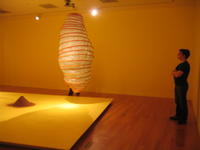sewing 101

it was amusing to see the breadth of sewing machines that materialised in the classroom. people lugged their 50lb vintage singer machines and electronic LCD-screen-bedecked embroidery brothers alike. i fell in the love with the avocado green mechanical monster with mod futuristic styling and an open bottom.
here's what i learned:
general
- there are two needles, one upper (visible) and one lower (bobbin, invisible).
- always turn the flywheel TOWARDS you. never ever turn it away from you.
- thread goes through the tension disks and through the take-up.
- thread the needle from front --> back, or right --> left.
- when you pop the bobbin in, make sure it spins CLOCKWISE. the bobbin tension is usually okay to leave it alone.
- pin perpendicularly to sewing seam (needle can jump over the pins)
- a "walking foot" is great for automatically adjusting for tension
- sewing machine requires regular oiling for maintenance
- basting
- the longest stitch ("4" on the knob)
- good for temporary seams, easy to rip out
- the stretch stitch is stronger, more durable
- zigzag
- for stretchy knit fabrics
- stronger stitch
- set the parameters for length and width of stitch
- the selvage is the finished edge of the fabric piece
- the strongest axis is parallel to the selvage (straight grain)
- the 2nd strongest axis is orthogonal to the selvage (cross grain)
- fabrics are always weak and stretch out on the bias
- recommended: schmetz needles
- sizes are 9 to 18; 14 is common use, 16-18 for thicker fabrics like denim
- need special needle for leather
- need ballpoint needle for knits
- insert needle into machine with flat side towards the back
- first finish edges with a zigzag stitch to prevent raveling
- fold once, then twice over, and then hem
- use zipperfoot, which is also handy for sewing wiring or cording
- use basting stitch to seam two pieces together
- press seam open with an iron
- put zipper face-down on the seam
- pin in place
- sew down, across, and up (U-shape)
- wiggle needle to manuever through teeth
- rip out the basting seam
- use the stitch that looks straight with poking out to the left
- first finish the edges to prevent unraveling
- fold once, then another in the other direction (accordion-style)
- sew so that most of the stitching is on the edge, but the tips of the points barely catch onto the fold of the fabric
- use color-matching thread!
next time i'm at winmil, i'll take a look at their fabric selection and see if i can make myself an easy A-line skirt next weekend...








